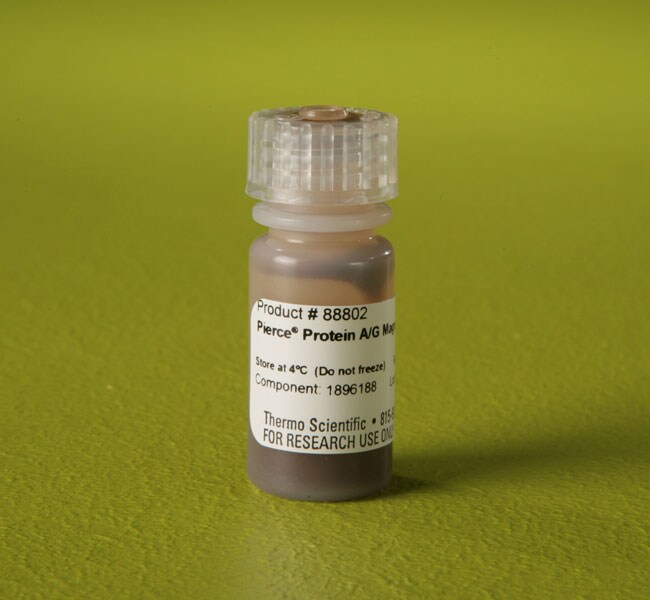Search Thermo Fisher Scientific

Pierce™ Protein A/G Magnetic Beads
| Catalog Number | Quantity |
|---|---|
| 88802 | 1 mL |
| 88803 | 5 mL |
Thermo Scientific Pierce Protein A/G Magnetic Beads are high-performance affinity particles for antibody purification and immunoprecipitation methods using manual or robotic magnetic separators.
Features of Protein A/G Magnetic Beads:
- High capacity—nearly four times higher binding capacity than typical magnetic beads from other suppliers, allowing the use of smaller amounts per experiment
- Low non-specific binding—stable, pre-blocked beads provide clean purification products (e.g., antigen eluted in IP with antibody is devoid of contaminating proteins from complex IP matrix)
- Flexibility—convenience of IgG binding domains of both Protein A and Protein G on one bead
- Compatibility—beads are compatible with manual and automated applications (e.g., Thermo Scientific KingFisher Instruments)
- Assay consistency—magnetic beads eliminate resin loss and provide for more efficient separation of solutions than traditional IP methods that use only microcentrifuge tubes
These magnetic beads are coated with genetically engineered Pierce Protein A/G, a recombinant fusion protein which combines the IgG binding domains of both Protein A and Protein G. This enables capture of antibodies from a wider range of species and isotypes than either protein alone. Using our crosslinker chemistry, you can immobilize an antibody onto the magnetic particle and prevent IgG contamination in your immunoprecipitated sample. These beads can be used both manually with a magnetic stand as well as with automated platforms such as the Thermo Scientific KingFisher Instruments.
Applications:
- IP and Co-IP experiments (see complete kit)
- Immunoprecipitation for analysis in non-reducing conditions
- Antibody purification
The recombinant Protein A/G that is immobilized onto the Pierce Magnetic Beads is a fusion of the IgG binding domains of both Protein A and Protein G. Protein A/G contains four Fc-binding domains from Protein A and two from Protein G, making it a convenient tool for investigating and purifying immunoglobulins. Thus, Pierce Magnetic Particles are not simply a mixed immobilization of separate Protein A and Protein G polypeptides, nor are they a mixture of Protein A magnetic beads and Protein G magnetic beads.
Figures




Customers who viewed this item also viewed
Documents & Downloads
Certificates
Safety Data Sheets
Scientific Resources
Product Information
Frequently asked questions (FAQs)
Pierce Protein A/G Magnetic Beads are intended for single use only. Therefore, we do not recommend reusing them.
Pierce Magentic Agarose Beads have a much higher binding capacity.
Find additional tips, troubleshooting help, and resources within our Protein Purification and Isolation Support Center.
No, centrifuging causes the formation of irreversible aggregates which greatly reduces binding capacity.
Find additional tips, troubleshooting help, and resources within our Protein Assays and Analysis Support Center.
Adding 50-350 mM of NaCl to the Binding/Wash and Elution Buffers can help reduce non-specific bands. Also, use a low-pH elution for single-use applications. The optimal time for low-pH elution is 10 minutes; exceeding 10 minutes may result in non-specific binding and yield reduction.
Find additional tips, troubleshooting help, and resources within our Protein Assays and Analysis Support Center.
Avoid bead-boil elutions when using rabbit antibodies (primary or secondary) in downstream Western blot applications. Instead, perform elution in SDS-PAGE sample buffer at room temperature. For all other antibody species, boiling the beads in SDS-PAGE sample buffer is acceptable for single-use applications. Boiling could cause bead aggregation and loss of binding activity.
Find additional tips, troubleshooting help, and resources within our Protein Assays and Analysis Support Center.